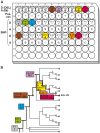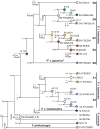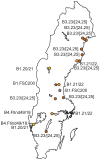A real-time PCR array for hierarchical identification of Francisella isolates
- PMID: 20027310
- PMCID: PMC2793073
- DOI: 10.1371/journal.pone.0008360
A real-time PCR array for hierarchical identification of Francisella isolates
Abstract
A robust, rapid and flexible real-time PCR assay for hierarchical genetic typing of clinical and environmental isolates of Francisella is presented. Typing markers were found by multiple genome and gene comparisons, from which 23 canonical single nucleotide polymorphisms (canSNPs) and 11 canonical insertion-deletion mutations (canINDELs) were selected to provide phylogenetic guidelines for classification from genus to isolate level. The specificity of the developed assay, which uses 68 wells of a 96-well real-time PCR format with a detection limit of 100 pg DNA, was assessed using 62 Francisella isolates of diverse genetic and geographical origins. It was then successfully used for typing 14 F. tularensis subsp. holarctica isolates obtained from tularemia patients in Sweden in 2008 and five more genetically diverse Francisella isolates of global origins. When applied to human ulcer specimens for direct pathogen detection the results were incomplete due to scarcity of DNA, but sufficient markers were identified to detect fine-resolution differences among F. tularensis subsp. holarctica isolates causing infection in the patients. In contrast to other real-time PCR assays for Francisella, which are typically designed for specific detection of a species, subspecies, or strain, this type of assay can be easily tailored to provide appropriate phylogenetic and/or geographical resolution to meet the objectives of the analysis.
Conflict of interest statement
Figures




Similar articles
-
Phylogeography of Francisella tularensis: global expansion of a highly fit clone.J Bacteriol. 2009 Apr;191(8):2474-84. doi: 10.1128/JB.01786-08. Epub 2009 Feb 27. J Bacteriol. 2009. PMID: 19251856 Free PMC article.
-
Whole genome single nucleotide polymorphism based phylogeny of Francisella tularensis and its application to the development of a strain typing assay.BMC Microbiol. 2009 Oct 7;9:213. doi: 10.1186/1471-2180-9-213. BMC Microbiol. 2009. PMID: 19811647 Free PMC article.
-
Tularemia in Denmark: identification of a Francisella tularensis subsp. holarctica strain by real-time PCR and high-resolution typing by multiple-locus variable-number tandem repeat analysis.J Clin Microbiol. 2005 Oct;43(10):5355-8. doi: 10.1128/JCM.43.10.5355-5358.2005. J Clin Microbiol. 2005. PMID: 16208017 Free PMC article.
-
Molecular epidemiology, evolution, and ecology of Francisella.Ann N Y Acad Sci. 2007 Jun;1105:30-66. doi: 10.1196/annals.1409.011. Epub 2007 Apr 13. Ann N Y Acad Sci. 2007. PMID: 17435120 Review.
-
The development of tools for diagnosis of tularemia and typing of Francisella tularensis.APMIS. 2004 Nov-Dec;112(11-12):898-907. doi: 10.1111/j.1600-0463.2004.apm11211-1212.x. APMIS. 2004. PMID: 15638842 Review.
Cited by
-
Ecology of Francisella tularensis.Annu Rev Entomol. 2020 Jan 7;65:351-372. doi: 10.1146/annurev-ento-011019-025134. Epub 2019 Oct 10. Annu Rev Entomol. 2020. PMID: 31600457 Free PMC article. Review.
-
Variant site strain typer (VaST): efficient strain typing using a minimal number of variant genomic sites.BMC Bioinformatics. 2018 Jun 11;19(1):222. doi: 10.1186/s12859-018-2225-z. BMC Bioinformatics. 2018. PMID: 29890941 Free PMC article.
-
Francisella tularensis Susceptibility to Antibiotics: A Comprehensive Review of the Data Obtained In vitro and in Animal Models.Front Cell Infect Microbiol. 2017 Apr 11;7:122. doi: 10.3389/fcimb.2017.00122. eCollection 2017. Front Cell Infect Microbiol. 2017. PMID: 28443249 Free PMC article. Review.
-
Melt analysis of mismatch amplification mutation assays (Melt-MAMA): a functional study of a cost-effective SNP genotyping assay in bacterial models.PLoS One. 2012;7(3):e32866. doi: 10.1371/journal.pone.0032866. Epub 2012 Mar 16. PLoS One. 2012. PMID: 22438886 Free PMC article.
-
Increased knowledge of Francisella genus diversity highlights the benefits of optimised DNA-based assays.BMC Microbiol. 2012 Sep 25;12:220. doi: 10.1186/1471-2180-12-220. BMC Microbiol. 2012. PMID: 23009728 Free PMC article.
References
-
- Dennis DT, Inglesby TV, Henderson DA, Bartlett JG, Ascher MS, et al. Tularemia as a biological weapon: medical and public health management. JAMA. 2001;285:2763–2773. - PubMed
-
- Saslaw S, Eigelsbach HT, Wilson HE, Prior JA, Carhart S. Tularemia vaccine study. I. Intracutaneous challenge. Arch Intern Med. 1961;107:689–701. - PubMed
-
- Saslaw S, Eigelsbach HT, Prior JA, Wilson HE, Carhart S. Tularemia vaccine study. II. Respiratory challenge. Arch Intern Med. 1961;107:702–714. - PubMed
Publication types
MeSH terms
Substances
LinkOut - more resources
Full Text Sources
Molecular Biology Databases

